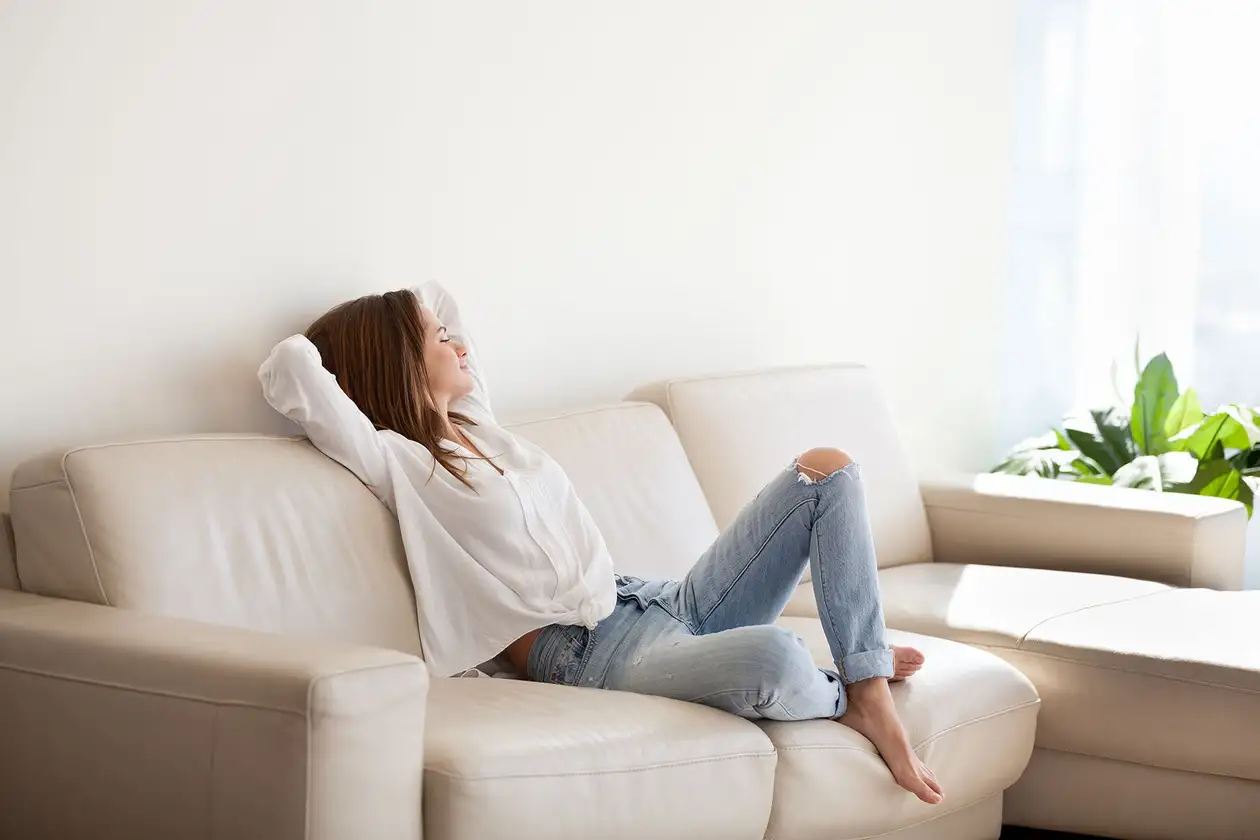
8 Advantages of floor heating systems
Energy-saving, cosy, hygienic: A floor heating system ensures not just warm feet, but a whole range of significant advantages – in new constructions as well as in renovation projects.

Impressive across the entire surface
No matter whether refurbishing or constructing a new building: The choice of heating system is crucial for the energy efficiency of your property. A good reason, then, to consider the many advantages of a floor heating system from the outset. We have put together the eight most important design, heating technology and ecological aspects for you – from installation and heating costs to heat distribution.
#1 Efficient and sustainable

The most important thing first: A modern floor heating system pays for itself many times over - for owners or residents as well as for the environment. The efficiency advantage depends directly on its construction: The floor heating system counts as a radiant panel heating system and – unlike a conventional system with radiators installed at certain points – uses a much larger surface area to heat the room. This means that it also operates at a much lower water temperature, referred to as the supply temperature.
Greater surface area, lower supply temperature – considerable savings potential
Every degree of supply temperature that is saved reduces the amount of precious energy needed to heat the water, which results in a lower heating bill. At the same time, the floor heating system is an excellent fit for combined use with sustainable, modern heat pumps. An additional benefit for people and the environment: Systems with a low assembly height such as Schlüter-BEKOTEC-THERM require less screed, which of course saves resources such as sand and cement, thus further reducing the ecological footprint of a building. The thin screed layer also means that they heat up more quickly. The fact that all this pays off in the end is also confirmed by a scientific study by the Institute for Technical Building Services (ITG) in Dresden: Compared to conventional floor heating systems, an annual energy saving of up to 9.5 % is possible with the BEKOTEC-THERM system.
Sustainable investment in the energy of the future
The energy efficiency of buildings is becoming increasingly important with respect to value retention and value creation in property. Not only does a modern radiant panel heating system represent a sustainable gain in efficiency, but also a pioneering energy distribution system that is ideal for utilising – and even for retrofitting – regenerative energy systems. In the face of rising energy costs and falling prices for solar systems and heat pumps, this is an unbeatable advantage that is not lost on the market: the market value of real estate with floor heating systems is frequently significantly higher than comparable properties equipped with conventional radiators.
What is the supply temperature?
The supply temperature is the temperature of the medium that transfers heat to the heating system – in this case, water. The required supply temperature level depends on the heat dissipating surfaces and the heat requirements of each space. The supply temperature for conventional radiator systems is approx. 60°C, whereas modern floor heating systems require only approx. 30°C. This makes it the ideal partner for combination with heat pumps and solar technology, with sufficient excess energy to heat utility water for your bathroom and kitchen.
#2 Short construction time possible

The installation of a modern heating system does not necessarily involve lengthy construction times. Perfectly coordinated systems such as Schlüter-BEKOTEC-THERM or Schlüter-DITRA-HEAT-E are designed in such a way that tiles or natural stone pavers can even be installed as soon as the screed is ready to bear weight. This is made possible by what is known as an uncoupling mat. It is installed between the screed and tile and ensures that both layers can move independently of each other – including vapour pressure equalisation and waterproofing.
Up to 28 days sooner in your new home
When using a conventional cement screed, it is no longer necessary to wait for the screed to dry and the time-consuming functional heating and curing. The uncoupling mat also means that residual moisture does not need to be measured or checked when installing ceramic floor coverings, resulting in a total time saving of up to four weeks – a huge advantage for both new building projects and refurbishment projects.
Clever design, efficient installation
In modern heating systems such as BEKOTEC-THERM, the heating screed is installed on a studded panel that also accommodates the heating pipes. This assembly type requires a significantly thinner layer of screed, which not only saves resources, weight and assembly height, but also time during installation – because additional work such as creating screed movement joints, installing an AKS grid or the use of expensive additives is no longer necessary. A screed produced like this can be installed much faster: Whereas conventional screeds can be installed at a rate of approx. 70 m2 per day, the BEKOTEC system can be increased to approx. 100 m2 per day.
#3 Can be retrofitted to existing buildings

In the case of renovation or refurbishment, the assembly height of the floor construction is often limited. When constructing a conventional screed floor, a screed quantity of 61 litres or 122 kilogrammes per square metre is also assumed – too high a static load in many existing properties. For such applications, there are special screed constructions based on studded panels: They can also be used to build low constructions including floor heating systems.
Material and weight reduced to the bare essentials
Floating screed constructions produced on studded panels are also characterised by low assembly heights and reduced material usage. The flat design of the BEKOTEC-THERM system also results in minimal screed masses with a surface weight from 40 kg/m2 – a saving of up to 80 kilograms per square metre. This not only means lower costs and resources, but also such low static loads that floor heating systems can easily be used in renovations of old buildings and even in listed buildings without any problem.
What is a studded panel?
A studded panel or studded screed panel is a plastic sheet with a stud-like structure. It is installed under the screed and is used to accommodate heating pipes for the floor heating system, which are fixed in place between the studs. Studded panels are available for various assembly heights and pipe diameters as well as with and without thermal or impact sound insulation.
Screed constructions with Schlüter-BEKOTEC studded panels have numerous advantages over a conventionally installed screed: For example, tensions in the screed can be eliminated in a modular way via the studded panel grid, thus preventing potential warping – additional expansion joints in the screed are generally no longer necessary. In addition, the screed thickness is considerably reduced which saves material and weight as well as assembly height. Floor heating systems also react more quickly in these constructions, as there is less mass to heat up.
#4 Refreshingly cool in the summer

The combination of heat pump and floor heating system can do more than just provide energy-efficient heating: a cooling function is also possible during the summer months. The principle is simple: Instead of cooling the room air directly, the surface is used to lower the temperature in the building to a cosy level. Instead of heated water at approx. 30 °C, cool water at approx. 18 °C now flows through the pipes installed in the floor. This extracts heat from the rooms, which then reduces the temperatures of the surfaces and, ultimately, the air in the building. A difference of just a few degrees is enough to markedly improve the room environment.
The changeover between heating and cooling mode takes place via the so-called change-over output of the heat pumps, which provides a corresponding signal to the floor heating system. This effectively reverses the direction of action of the actuators: They open when the room temperature rises (instead of it otherwise falling) and enable cold water to flow through the heating circuits. Although the cooling effect is actually less than with an air conditioning system, the indirect effect means that there are no cold draughts, whirling up of dust or noise pollution. Surface cooling is therefore often regarded as more pleasant and, depending on the type of heat pump installed, can be used as either an active or passive cooling system.
Passive cooling: removal of heat into the ground
A passive cooling system uses heat pumps with ground collectors or depth drilling. The heat from the living space is absorbed by the floor heating system and transported into the cooler ground via the circulation of the heat transfer medium and cooled down. Whereas the ground heats up slightly, the building is cooled by the floor heating system – and this is extremely cost-effective, environmentally-friendly with no high electricity consumption, as the heat pump operates with the compressor switched off during passive cooling. While it is true that this cooling capacity cannot be compared with conventional cooling units, it also works according to a very different – indirect – principle.
Active cooling: transport of cold water to the surface
In the case of active cooling, for instance with air-water heat pumps, the cooling performance of the heat pump is transferred to the heating system: The compressor of the heat pump is switched on, i.e. the heat pump is "active". As a result, active cooling operation is associated with higher power consumption than passive cooling – but also achieves higher cooling capacities.
The floor structure influences the heating and cooling performance
How quickly the room is cooled down to a comfortable temperature in the summer also depends on the floor construction. Basically, thin-layer screed constructions enable much faster reaction times. The surface covering also plays a significant role: Due to their thermal conductivity, the best cooling performances can be achieved with tiles or natural stone. Put in real terms, the combination of the various BEKOTEC-THERM systems with tiles achieves average cooling capacities of 30-40 W/m², which corresponds to a reduction in room temperature of approx. 3 °C.
#5 Walls without radiators

Dispensing with radiators in living rooms, workrooms or business spaces has design advantages at first glance: By banishing the heating system to the floor, there is more space for your furnishings. The rooms become larger in size, allowing them to be planned and used much more freely according to your personal preferences.
Thermal comfort comes from surfaces
Deciding in favour of a heating system without radiators also has a direct effect on the comfort of a room. People perceive warmth as particularly pleasant when
- there are no draughts in the room,
- the temperature between the room air and surrounding surfaces is almost the same as far as possible and
- the head and feet are roughly the same temperature.
A radiant panel heating system fulfills all these requirements, because a much larger area is heated up compared to conventional radiators – with no need for air movement to distribute the heat. As the floors and walls do not have to be heated by the air, it also requires a temperature difference of no more than a few degrees to the room air. This results in a whole new dimension of cosiness and living comfort.
Heat distribution in comparison with air movement


#6 At its best with ceramic tiles
The efficiency of a floor heating system is directly influenced by the installed floor covering: The better its thermal conductivity, the more energy efficiently and cost effectively the system can work. Floor coverings with insulating properties are thus out of place on a heated floor – instead, excellent heat conductors are required, which also pass on low supply temperatures with as little loss as possible.
It's all a matter of thermal conductivity
The ideal partners for a radiant panel heating system – from a physical point of view – are clearly coverings made of tiles and natural stone: Thanks to their high thermal conductivity, they can quickly and efficiently transmit the radiant heat provided by the heating system to the room. In combination with a thin-layer screed construction and an uncoupling mat directly under the tiles, this effect is accelerated even further. Not only does this ensure greater comfort, but also significantly more economical operation.

#7 Allergy sufferers breathe easier
Because floor heating systems work with radiant heat and only create a small temperature difference from the room air, they also generate just a fraction of the air movements caused by conventional heating. That explains why floor heating systems turn up less dust, which avoids unnecessary contaminants in the room air.
Staying healthy!
For those suffering from dust allergies, floor heating systems are a true revelation: Not only are there fewer allergens produced by dust mites, but the dry, heated substrate also robs the troublesome mites of their living environment, particularly in combination with sanitary, easy-care tiled floors.
#8 Consistently sanitary
Moisture easily dries up on heated floors – eliminating the risk of bacteria, fungi and mites. Whether you want to install a sanitary floor in your bathroom or kitchen or have young children, a floor heating system is the perfect solution for your home.
The public health sector has therefore long since discovered radiant panel heating systems for itself: Treatment rooms, operating rooms and sanitary rooms are increasingly equipped with radiant panel heating systems and suitable floor coverings that are easy to keep sterile. Heated floor coverings also dry more quickly in spa areas and bathrooms – thus reducing the risk of slipping caused by the need for cleaning or the moisture that occurs during use.
Overview of the advantages of floor heating systems

At its best with ceramic tiles
High thermal conductivity, low energy loss: Floor heating systems develop their full potential with floor coverings such as ceramic tiles or natural stone.
Short construction time possible
Thin layer, great effect: The combination of cement screed with an uncoupling mat allows the screed surface to be covered immediately as soon as it is ready to bear weight – without long waiting times.
Can be retrofitted to existing buildings
Whether in existing structures or listed buildings: Special variants with low assembly heights and low screed masses mean that floor heating systems are also suitable for renovation and refurbishment projects.
Walls without radiators
Dream living with no limits and maximum well-being: Installing the heating in the floor not only gives you more space for furnishing ideas – but also warmth for comfort.
Consistently sanitary
Whether in the kitchen, living room or bathroom: Heated surfaces prevent moisture, bacteria, fungi and mites from taking hold.
Allergy sufferers breathe easier
Cosy heat distribution without stirring up the air: because a floor heating system is able to heat the entire surface evenly, hardly stirring up any dust.
Efficient and sustainable
The decision to install a floor heating system pays off in several ways: Thanks to the lower supply temperature, it not only conserves resources and saves money – it also increases the market value of your property.
Refreshingly cool in the summer
A room environment to feel good in whatever the season: not only can water-based systems provide heating, they can also cool – without draughts, without stirring up dust and without any noise.


